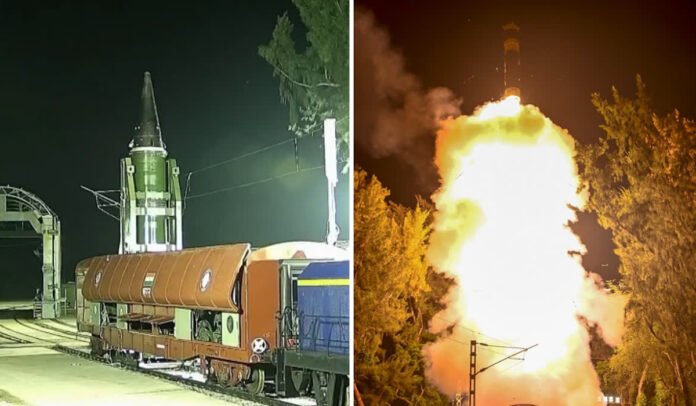India successfully conducted a test of its Agni Prime missile from a rail based mobile launcher system on Wednesday, marking the first such trial in the country’s strategic programme. Defence officials said the launch was fully successful and met all mission objectives, strengthening India’s deterrence capability.
The test was carried out under the supervision of the Defence Research and Development Organisation (DRDO) and the Strategic Forces Command (SFC). According to the Ministry of Defence, the missile was launched from a canister mounted on a specially designed rail platform capable of travelling across the rail network. Unlike fixed or prepared launch sites, the system can operate without pre conditioning, giving the armed forces greater flexibility.
Tracking stations, electro optical systems and radars monitored the missile’s trajectory from launch to impact. Officials confirmed that the performance was consistent with expectations and that the missile struck its designated target with precision.
The Agni Prime, also called Agni P, is an intermediate range ballistic missile with a range of 1,000 to 2,000 kilometres. It is the latest in the Agni series that forms the backbone of India’s nuclear deterrent. Earlier road mobile versions have already been inducted, and the rail based trial marks a step forward in mobility and survivability.
Defence Minister Rajnath Singh congratulated DRDO, SFC and the armed forces on the successful test, saying it demonstrated India’s ability to develop advanced missile systems with indigenous technology. He added that the achievement places India among a select group of nations capable of operating canisterised rail launched missiles.
Officials explained that the ability to launch from rail enhances operational unpredictability and increases survivability in a conflict. Mobile platforms can move across large areas, remain concealed, and deploy rapidly, thereby strengthening India’s second strike capability under its nuclear doctrine.
The Agni Prime incorporates advanced composite materials, improved navigation and guidance systems, and enhanced accuracy. It is lighter and more efficient than earlier Agni models, which makes it easier to transport and operate in diverse conditions.
The Ministry of Defence emphasised that the test was conducted in a full operational scenario, meaning that all procedures and systems were used as they would be during deployment. This validation, they said, confirms that the missile is ready for induction in multiple configurations.
Analysts believe the trial carries significant strategic implications. By diversifying launch platforms to include both road and rail, India makes it harder for adversaries to track its assets. In the broader regional context, the missile provides a credible deterrent against threats from both western and northern fronts.
The rail launcher adds to India’s push for self reliance in critical defence technology. The Agni series has long symbolised indigenous capability, and the Prime variant shows how the country is adapting older designs with modern innovation.
With this success, the Agni Prime rail version is closer to induction. Further user trials are expected, but officials say the system is on track to join the arsenal of the Strategic Forces Command in the near future.

























